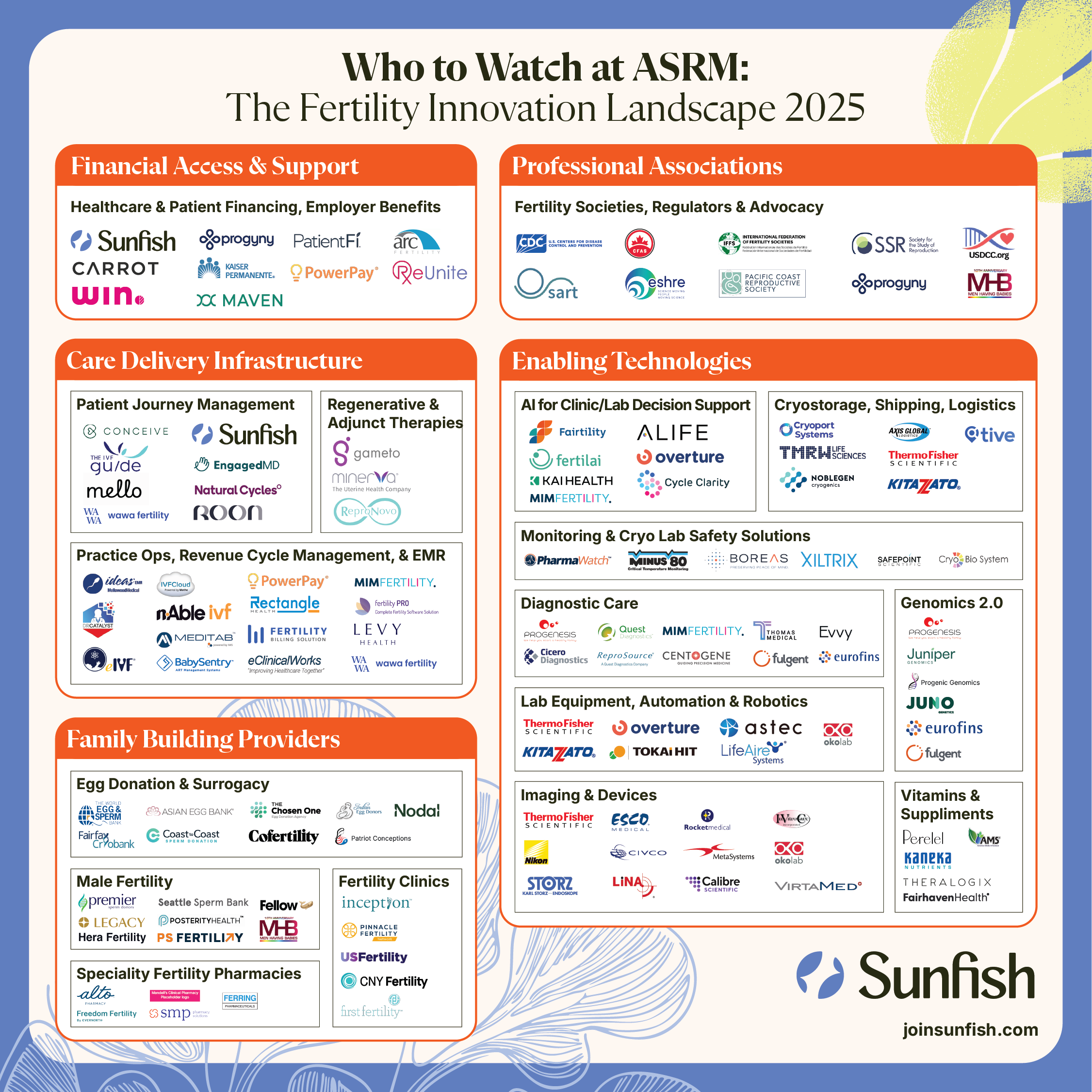Start-ups and Technology Are Reshaping Fertility: 3 Trends to Watch at ASRM 2025
October is a big month in the Assisted Reproductive Technology (ART) sector, or, as many call it, the fertility industry. Every year, thousands of reproductive endocrinologists and industry professionals gather at the American Society of Reproductive Medicine (ASRM) annual summit to discuss innovation, share scientific breakthroughs, and collaborate on the future of family building.
Inside the ASRM Expo Hall
A highlight of this event is the expo hall, where hundreds of companies showcase their solutions for improving IVF and family building. Ahead of this year’s event, we mapped the landscape of exhibitors to identify key sectors and emerging trends across the ART ecosystem.
Of the approximately 250 presenters, only 25% are what we call family-building providers. These are fertility clinics, specialty pharmacies, male reproductive health companies, egg donation, and surrogacy groups. The remaining 75% fall into four main categories:
- Financial Access & Support: Financing solutions, employer benefits, and center of excellence (COE) networks
- Care Delivery Infrastructure: Patient journey management, interoperability and data systems, monitoring, practice operations, and EHRs
- Professional Associations: Professional societies and reporting bodies
- Enabling Technologies: AI and equipment for lab decisions, diagnostic care, imaging, and devices

Three Trends You Should Watch
After years of walking the ASRM expo hall, I’ve come to see it as the best way to check the pulse of fertility innovation. The companies on display reveal not just new technologies, but how our field is evolving—driven by patient demand, new ways of measuring outcomes, and rapid advances in AI and data. Ahead of this year’s conference, I connected with several colleagues to gather their perspectives on three key trends shaping the future of reproductive care.
Trend 1: Innovation is Accelerating
The momentum in fertility innovation is undeniable. The global fertility market is worth an estimated $46 billion and is expected to more than triple in the next decade, according to IMARC research. The pace of this innovation is creating unprecedented opportunities to improve outcomes and access for patients.
Growth is reflected across the market map. Dr. Eduardo Hariton, VP of Strategic Initiatives at US Fertility and Managing Director of the USF Innovation Fund, tells me, “The surge of innovation is being driven by three converging forces: workforce bottlenecks that demand efficiency, growing patient demand for access and transparency, and the maturation of AI and data infrastructure.”
As a result of this convergence, more startups are entering the space with novel solutions, venture capital funding continues to increase, and established healthcare companies are making strategic moves into fertility. This influx of capital and talent is driving rapid advancement across every category—from lab technologies and AI applications to patient experience platforms and financing models.
Trend 2: AI and Robotics Are Transforming Where and How Care Happens
Technology is revolutionizing reproductive medicine and changing where some care takes place. From AI-assisted embryo selection to advanced cryopreservation techniques, labs are onboarding new techniques. Elsewhere, “advances in wearables, artificial intelligence, and other digital technologies will enable earlier identification of fertility needs and provide personalized support in the comfort of people's homes," says Dr. Neel Shah, Chief Medical Officer of Maven Clinic.
However, as in all areas of healthcare, it's critical to keep the experts in the equation.
Dr. Mark Leondires, Founder and Medical Director at Illume Fertility, tells me, "technology is changing the way we practice reproductive medicine and patients are also using it to gather more information on their own. Our team embraces technological advances and the positive changes they can bring.”
But Dr. Leondires cautions patients to remember that the guidance of an experienced healthcare professional is a key part of their experience. He says, “it’s essential for patients to remember that information without context may not always be useful and can sometimes create anxiety.”
Trend 3: “Cost to Baby” Represents A Shift Toward Value-Based Care
Industry leaders are increasingly focused on the total "cost to baby," meaning, how much it really costs to have a baby—from beginning treatment to live birth. At Sunfish, we estimate that an average IVF baby costs about $70,000. Whether you're an employer offering benefits, an insurer, or a family paying out of pocket, someone bears this significant expense.
In the medical community, it’s increasingly seen as important to both bring costs down and improve access by controlling costs. By looking at “cost to baby,” organizations are trying to understand what works (or doesn’t) in order to build better businesses.
"Fertility care is increasingly shifting from a reactive and clinic-centered approach to a proactive and person-centered approach,” says Dr. Shah. Indeed, at Sunfish, our number one goal is to help each family find a viable financial pathway to parenthood based on their unique treatment plans, using AI-based predictive modeling that’s highly personalized.
What Does it Take to Succeed?
With the constant stream of new entrants into the sector and new technologies available, leaders looking to succeed need to pair forward-looking ideas with deep knowledge of how the industry operates.
"New entrants that succeed in fertility tend to deeply understand the realities of clinical practice,” says Dr. Hariton. “They don't just bring technology, they bring solutions that integrate seamlessly into complex workflows and create real value for both patients and providers.”
He continues, “the most successful partnerships are built on humility, speed, and a shared commitment to improving care."
I could not agree more.
Join Us at ASRM
Stop by the Sunfish booth to learn about how we’re helping grow access to family-building—or come chat with me about trends you see in our industry. You can download our full map of exhibitors, organized by category, HERE. With over 200 exhibitors, we couldn't fit every logo in our market map! Or, click here for the official map of the ASRM Expo Hall.






